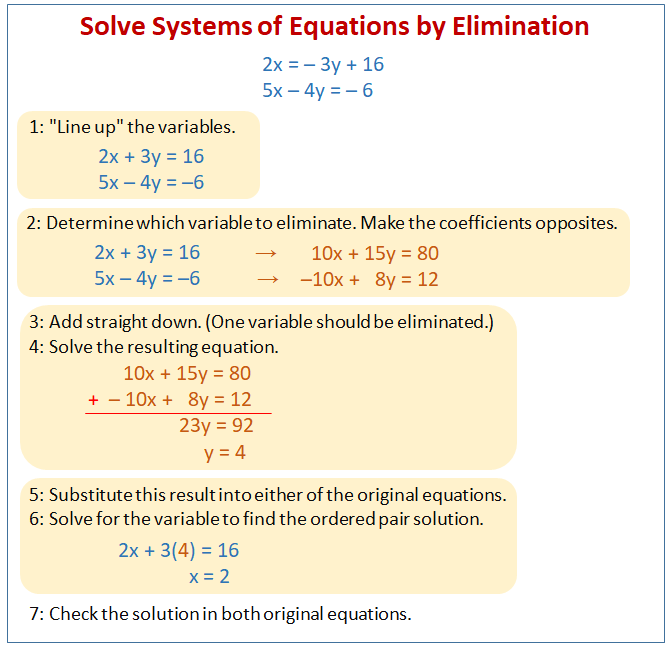Solving Systems of Equations Using Elimination By Addition
Related Topics:
More Lessons for Algebra
Math Worksheets
Examples, solutions, videos, worksheets, games, and activities to help Algebra 1 students learn how to solve systems of linear equations using the elimination method or addition method.
Solving Systems of Equations Using the Elimination Method (or Addition Method) The Elimination Method (also known as the Addition Method) is a powerful technique for solving systems of linear equations. The core idea is to manipulate the equations in a way that allows you to eliminate (cancel out) one of the variables when you add or subtract the equations. This leaves you with a single equation that has only one variable, which is then easy to solve.
The following diagram shows an example of solving systems of equations by elimination by addition. Scroll down the page for more examples and solutions of solving systems of equations.

Algebra Worksheets
Practice your skills with the following worksheets:
Printable & Online Algebra Worksheets
Steps to Solve a System of Equations Using Elimination:
- Align the Equations
Write both equations in standard form (Ax + By = C). - Choose a Variable to Eliminate
Decide which variable (x or y) you want to eliminate. Look for variables that already have opposite coefficients (e.g., 2y and −2y) or coefficients that are easy to make opposites. - Multiply One or Both Equations (If Necessary)
If the coefficients of the chosen variable are not opposites, multiply one or both equations by a suitable constant so that they become opposites. The goal is to make them the same number with opposite signs (e.g., if you have 3x and 2x, you could multiply the first by 2 and the second by -3 to get 6x and −6x). - Add the Equations
Add the corresponding terms (x-terms, y-terms, and constants) of the two equations together. If you’ve done Step 3 correctly, one variable should cancel out, leaving you with an equation that has only one variable. - Solve for the Remaining Variable
Solve the new single-variable equation for that variable. - Substitute Back
Substitute the value you just found back into one of the original equations (either Equation 1 or Equation 2) to solve for the other variable. Choose the simpler equation to avoid unnecessary calculations. - Check Your Solution
Substitute both values you found (the ordered pair (x,y)) into both original equations to ensure they satisfy both equations.
Special Cases in Elimination
Sometimes, when using the elimination method, both variables might cancel out.
Case A: No Solution (Inconsistent System)
If, after adding the equations, both variables cancel out and you are left with a false statement (e.g., 0=5 or 3=−2), then the system has no solution. This means the lines are parallel and never intersect.
Case B: Infinitely Many Solutions (Consistent and Dependent System)
If, after adding the equations, both variables cancel out and you are left with a true statement (e.g., 0=0 or 7=7), then the system has infinitely many solutions. This means the two equations represent the exact same line.
Videos
Solving Systems of Equations… Elimination Method
How to use the elimination method to solve a system of linear equations (simultaneous equations)?
Example 1: where terms cancel right away when you add the equations.
Example 2: Multiply one equation by a number before adding the equations
Example 3: Multiply both equations by numbers before adding.
Example 4: How to subtract equations instead of adding them.
How to Solve Systems of Equations Using Elimination By Addition?
- Line up the variables.
- Determine which variables to eliminate. Make the coefficients opposites.
- Add straight down. (One variable should be eliminated).
- Solve the resulting equation.
- Substitute the result into either of the original equation.
- Solve for the variable to find the ordered pair solution.
- Check the solution to both original equations.
Solving Systems of Equations
Students learn to solve a system of linear equations by addition
To solve a system of equations by addition, the goal is to cancel out one of the variables by adding the equations together. Students may need to multiply one or both of the equations by a number in order to set up a situation where one of the variables will cancel out when the equations are added together.
Solving a system of two equations in two variables by the addition method
Solving Systems of Linear Equations Using Elimination By Addition
Two complete examples and part of a third problem are shown!
Solve Systems of Linear Equations by Elimination
Try out our new and fun Fraction Concoction Game.
Add and subtract fractions to make exciting fraction concoctions following a recipe. There are four levels of difficulty: Easy, medium, hard and insane. Practice the basics of fraction addition and subtraction or challenge yourself with the insane level.

We welcome your feedback, comments and questions about this site or page. Please submit your feedback or enquiries via our Feedback page.